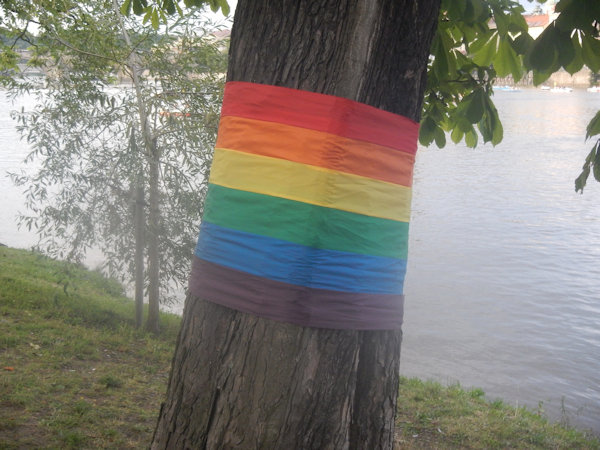SEJournal Online is the digital news magazine of the Society of Environmental Journalists. Learn more about SEJournal Online, including submission, subscription and advertising information.
 |
 |
| While climate desks have grown savvier in how they report on race and class, the author sees a gap in environmental coverage on queer and trans communities. Photo: Kennet Kjell Johansson Hultman (CC0 Public Domain). |
Voices of Environmental Justice: The Community We’ve Long Ignored
By Yessenia Funes
Voices of Environmental Justice, my new quarterly column for SEJournal, focuses on the voices that environmental and climate journalists have long excluded from their stories: Black and Brown folks, queer folks, disabled folks, migrant folks, non-English speaking folks and the list goes on. The column will feature interviews with community members, as well as practical tips and resources to help reporters better cover these communities. After all, these are some of the most affected by the world’s ecological crises. Their stories need to be told.
I began writing about climate change and environmental issues back in 2014 when I was still a college student. I’ve always connected my work back to my own identity as a Latina who grew up without wealth in the segregated immigrant suburbs of Long Island, New York — but it wasn’t until 2017 that I saw how my queerness played a role, too.
That year, a study found that same-sex partners across the United States face higher cancer and respiratory risks from air pollution than their neighbors in heterosexual relationships. I covered that groundbreaking research for Autostraddle, shedding light on how urban gayborhoods are environmental justice communities, too.
If LGBTQIA+ people suffer
disproportionate health risks
in general, how can climate change
and environmental pollution
exacerbate those risks?
Writing about that study and interviewing my sources illuminated an intersection I hadn’t considered at that point in my career: If LGBTQIA+ people suffer disproportionate health risks in general, how can climate change and environmental pollution exacerbate those risks?
Many news teams still lack this lens. Sure, climate desks have grown savvier in how they report on race and class, but a gap remains in how we cover our queer and trans communities. Their stories also fall within the environmental justice beat. We just have to be willing to tell them.
Understand how social, political structures ‘make a disaster’
There are a number of topic areas that invite coverage of LGBTQIA+ issues.
“First, remember that queer and trans individuals make up all populations,” said Leo Goldsmith, senior climate and health specialist at ICF, a consulting company that contracts with the federal government.
If you’re doing an environmental justice story on a tribal nation or a predominantly Black town, consider zooming into the impacts on an LGBTQIA+ community member. The story will only grow richer as a result.
LGBTQIA+ folks are some of the
most marginalized in the United States.
So when disaster strikes, they tend
to be most negatively affected.
That’s because LGBTQIA+ folks are some of the most marginalized in the United States. We’re more likely to be impoverished and unhoused. We suffer higher rates of chronic illnesses like asthma and cardiovascular disease. We are also more likely to have mental health issues, such as anxiety, depression and PTSD.
When disaster strikes — be it a wildfire, hurricane, heat wave or air quality alert — people living under these circumstances tend to be most negatively affected.
“These disasters aren’t natural,” Goldsmith said. “It’s really the social and political structures that have been created that make a disaster what a disaster is.”
In the United States, LGBTQIA+ members are losing their social and political safety nets at alarming rates. States are passing laws restricting access to gender-affirming health care while criminalizing our community by banning drag shows and books that talk about sexuality.
For the first time ever, the LGBTQIA+ rights organization Human Rights Campaign has declared a state of emergency for LGBTQIA+ Americans.
Take time to do these stories well
This right-wing attack on human rights is one of the most urgent stories of our time. So is climate change. Environmental reporters must learn to marry the two.
Ezra David Romero does an excellent job of that. As the climate reporter for KQED News in California’s Bay Area, Romero has written extensively about sea level rise and drought. He grew up in the Central Valley, one of California’s most-polluted regions, where most residents are Latine*.
“I come from this world where even though we’re the majority, the stories about us are the minority,” Romero said.
As a gay Latino, however, stories that center LGBTQIA+ people of color are especially personal to him. In 2022, he published a story on how disaster planning often excludes queer and trans folks. The story revolved, in part, around a new study that found the prevalence of faith-based groups in disaster response, as well as the lack of recognition for LGBTQIA+ family dynamics, creates a dangerous culture for queer folks after a disaster.
Romero could have written a quick-turnaround piece on the research, but he wanted to humanize its findings. As he said, he wanted to “make this story about real people’s lives.” So that’s exactly what he did.
Time is not always a resource that
journalists have, but it is something
journalists need if they want to
do these types of stories well.
He focused on trans farmworkers who were hit hard by the Tubbs Fire in 2017. Finding his main source — Paloma Reyes — took him about a month. Time is not always a resource that journalists have, but it is something journalists need if they want to do these types of stories well.
“People are wary of journalism, and they want to make sure that their stories are put out correctly,” Romero said. “We live in a world where queer people, especially trans people, are looked down upon and, in a lot of stories, they are tokenized.”
Romero’s own lived experience as a gay Latino pushed him to write a story that not only honored his sources but also highlighted the urgency of how climate change was transforming their lives.
His identity allowed his sources to trust him. As did his approach: “A lot of my reporting just comes down to care,” he said. “The basis of why we’re in a climate crisis is because these world powers don’t care. They’re in it for profit.”
Get educated on ecofascism
All journalists could use more care, especially in how we approach those who have faced generations of abuse and trauma from the media. In the case of environmental journalism, that’s especially true for disaster survivors — but extreme weather is just one avenue into including LGBTQIA+ voices in your reporting.
Jael Holzman, an energy and climate policy reporter for Axios, urges more journalists covering policy to educate themselves on ecofascism, an ideology that blames environmental destruction on immigrants, queer folks and other marginalized groups.
“Reporters need to recognize how environmentalism is part of hatred in this country and in many countries,” she said. “We talk about what ‘clean energy’ is without thinking about how the word ‘clean’ has been used to commit genocide for centuries.”
In Nevada, for example, Indigenous groups have been opposing a lithium mine — which would produce the materials needed for a clean energy transition. Holzman reported on the story in 2022 when she worked for E&E News.
Holzman broke a story about
the alarming transphobia that existed
among one environmental group.
In covering that news, she broke a separate story about the alarming transphobia that existed among one environmental group on the opposition: Deep Green Resistance, whose members call themselves “radical feminists,” a phrase for those who believe trans women aren’t women. (I would argue these people aren’t feminists at all.)
Holzman uncovered this reality only after a source warned her to be careful. You see, she is trans. And yet she still went to Nevada to tell that story. After all, no one else had.
“I have firsthand experience of covering environmental activists and, then, stumbling upon their desires for environmental protection colocating with their desires to exterminate LGBTQ people — and singularly trans people,” Holzman said. “We have a lot of conversations around environmental justice, but we rarely talk about environmental justice including the LGBTQ community.”
Do the work to build trust
Here’s the thing, though: You don’t have to be gay or trans or bi or any other queer identity to cover these issues. You simply have to care.
You have to do the work to build trust — and commit to persuading your editors to make space for such storytelling. You can be an ally and write these stories, too. You can support the queer folks in your newsroom so that they don’t always have to carry the burden of telling these (often heartbreaking) stories themselves.
Here are some quick tips and resources to use in the newsroom and in the field. But remember, there’s nothing quick about building a culture of inclusion. That takes time, and that’s OK. As Romero reminded me, time is most important when covering these issues. Don’t rush the process.
Tips:
- Always ask your sources and your colleagues for their pronouns and name pronunciation. Never assume.
- Offer your pronouns (in your email signature or in real-life conversations).
- Educate yourself on the diversity of the LGBTQIA+ community. Do you even know what each of those letters stands for?
- Give queer and trans peers space when the news is hard.
- Give them as much time as they need for their gender-affirming health care procedures.
- Speak out alongside — not for — your LGBTQIA+ peers.
Resources:
- “Disaster Response Must Help Protect LGBTQ+ Communities”
- “Queering Environmental Justice: Unequal Environmental Health Burden on the LGBTQ+ Community”
- “Overlooked and Overburdened”: 2022 federal webinar on extreme heat impacts
Groups:
- OUT for Sustainability
- Queers X Climate
- Queer Ecojustice Project
- Shelterwood Collective
- The Oath
- Venture Out
- EspicyNipples
- La Sombrilla Cuir
- Fenway Health
*There are multiple ways to identify Hispanic/Latino people. To be inclusive of nonbinary, gender nonconforming and trans folks, I will use the gender-neutral Latine. I acknowledge that different community members prefer other names to identify ourselves, including Latin, Latino, Latinx and Latin@.
 |
Yessenia Funes is an environmental journalist who has covered the justice beat for nearly a decade. She's written for publications like Atmos, Vogue, The Guardian, Earther, HuffPost and more. Her approach to storytelling amplifies the voices of those on the frontline of our present-day ecological crises. Her reporting has taken her to remote Indigenous communities in Nicaragua, the hostile desert of the American Southwest and post-Hurricane Maria Puerto Rico.
* From the weekly news magazine SEJournal Online, Vol. 8, No. 26. Content from each new issue of SEJournal Online is available to the public via the SEJournal Online main page. Subscribe to the e-newsletter here. And see past issues of the SEJournal archived here.












 Advertisement
Advertisement 



